| |
| 2.4 |
Main Organ for Photosynthesis |
|
| |
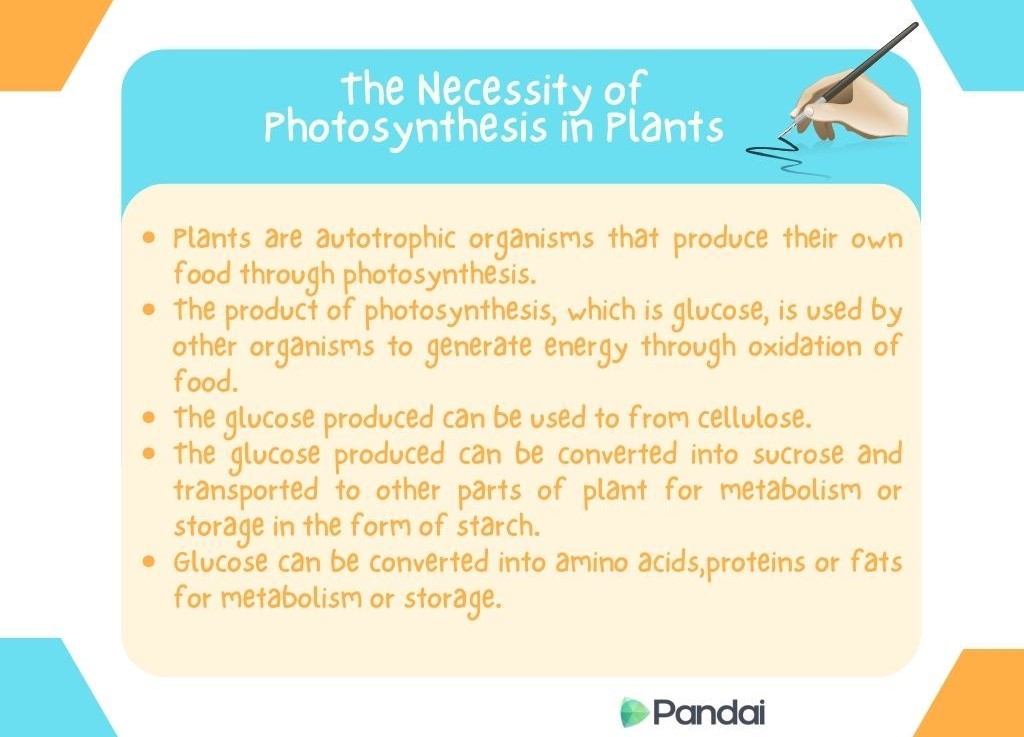 |
| |
| |
| The Necessity of Photosynthesis in Plants |
- Plants are autotrophic organisms that produce their own food through photosynthesis.
- The product of photosynthesis, which is glucose, is used by other organisms to generate energy through oxidation of food.
- The glucose produced can be used to from cellulose.
- The glucose produced can be converted into sucrose and transported to other parts of plant for metabolism or storage in the form of starch.
- Glucose can be converted into amino acids,proteins or fats for metabolism or storage.
|
|
| |
| Chemical Reaction of Overall Photosynthesis Process |
| \(12\text{H}_2\text{O}+6\text{CO}_2\xrightarrow[\text{chlorophyll}]{\text{light energy}}\text{C}_6\text{H}_{12}\text{O}_6+6\text{O}_2+6\text{H}_2\text{O}\) |
|
| |
| Process of Photosynthesis |
- Photosynthesis needs chlorophyll to absorb light energy from the sun, carbon dioxide from the atmosphere and water from the soil.
- Oxygen is released as a by-product.
- Besides the leaf being the main photosynthesis organ, young stem and other green parts of the plants are also able to carry out photosynthesis.
|
|
| |
| The Relation of Internal Leaf Structure Adaptation with Photosynthesis |
| Aspect |
Explaination |
| Leaf shape |
- Broad-increases surface area to absorb more sunlight.
- Thin-allow penetration of sunlight to reach lower layer of cells in leaf.
|
| Epidermis |
- Transparent-allow sunlight to penetrate into leaf.
- Cuticle-to reduce water loss from leaf.
|
| Palisade mesophyll |
- Cells which have abundant of chloroplasts-can carry out photosynthesis.
- Cylindrical shape of cells-more cells can be arranged compactly.
- Cells arranged compactly-absorb sunlight maximally for photosynthesis.
|
| Spongy mesophyll |
- Cells which have chloroplasts-can carry out photosynthesis.
- Irregular shaped of cells and loosely arranged-to form air spaces for transpiration and gaseous exchange.
|
| Xylem |
- Transport water and mineral salts from roots to mesophyll for photosynthesis.
|
| Phloem |
- Transport organic products from leaves to other parts of plants.
|
| Stoma |
- Pore that formed from two guard cells.
- For gaseous exchange and transpiration.
|
|
| |
| Chloroplast Structure |
|
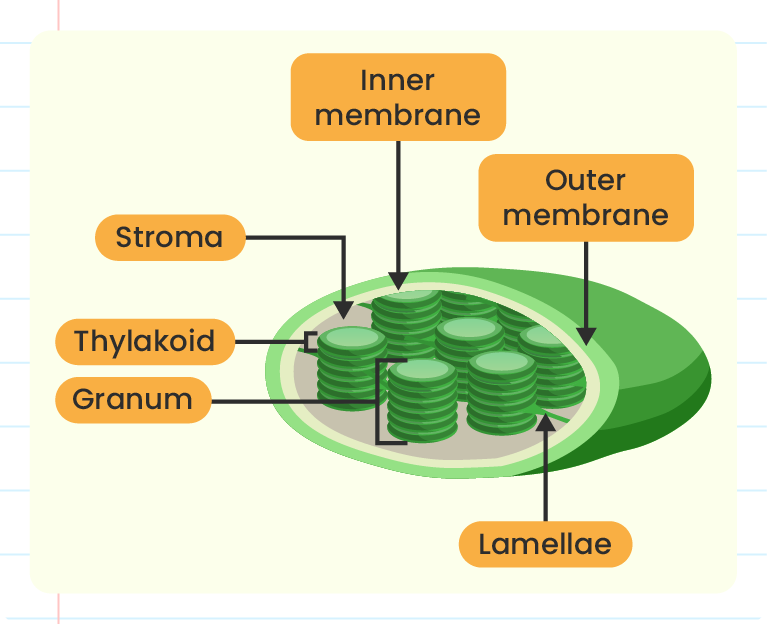
- The function of chloroplast is as a site for photosynthesis.
- A chloroplast contains chlorophyll to absorb sunlight and converts it into chemical energy during photosynthesis.
- Kloroplas terdiri daripada:
- Thylakoids:
- Disc-shaped sacs containing chlorophyll.
- In thylakoid membrane, there are photosynthetic pigments that trap sunlight.
- Light-dependent reaction occurs in the thylakoid.
- Granum:
- A disc-shaped stack of thylakoids.
- This arrangement increases the surface area for optimal photosynthesis.
- Stroma:
- Colourless fluid surrounding granum in the chloroplast.
- Site for light-independent reaction to take place which produces glucose.
|
|
| |
| Main Stages in Photosynthesis |
| Light-Dependent Reactions (Occurs in the Thylakoids) |
- In light-dependent reactions,chlorophyll absorbs light energy to becomes active and then releases electrons.
- At the same time,photolysis of water occurs in which a water molecule is splitted into hydrogen ion,oxygen and molecules.
- The oxygen gas produced is released into atmosphere.
- The electron released from water molecule will replace the electrons released from the chlorophyll.
- The electrons flow from chlorophyll eventually received by hydrogen ions and NADP+ to form hydrogen atoms and NADPH.
- During the flow of electrons from chlorophyll to hydrogen ions,some energy released from the electrons is used to synthesis ATP.
- The hydrogen atoms,NADPH and ATP produced from the light-dependent reactions will be used by the light independent reaction in stroma.
|
| Light-Independent Reactions (Occurs in the Stroma) |
- Carbon dioxide gas diffuses into chloroplast.
- The hydrogen atom, NADPH and ATP produced from the light-dependent reactions are used to reduce the carbon dioxide to produce glucose and water.
- The reduction process requires enzymes found in the stoma.
- The glucose produced form starch by condensation.
|
| The Overall Reaction for Photosynthesis can be Represented by the Following Chemical Reaction |

|
|
| |
| The Simillarities between the Light-Dependent and Light Independent Reactions |
- Occurs in daytime.
- Occurs in chloroplasts.
- Involves chemical reactions with enzymes.
|
| |
| The Differences of Light-Dependent and Light-Independent Reactions |
| Light-Dependent Reaction |
Light-Independent Reaction |
| Require light energy. |
Do not require light energy. |
| Occurs in granum and thylakoid. |
Occurs in stroma. |
| Photolysis of water takes place. |
Photolysis of water does not take place. |
| Produce ATP and NADPH. |
Do not produce ATP and NADPH. |
| Produce oxygen and water molecule. |
Produce glucose. |
|
| |
| Environmental Factors that Affect the Rate of Photosynthesis |
| Carbon Dioxide Concentration |
- The increase in carbon dioxide concentration increases the photosynthesis rate as long as there are no other limiting factors such as surrounding temperature and light intensity.
- At P, photosynthesis rate is constant.
- As the concentration of carbon dioxide increases after P, the rate of photosynthesis remains unchanged.
- This is due to light intensity becoming the limiting factor.
- The graph below shows the relationship between the rate of photosynthesis and carbon dioxide concentration.
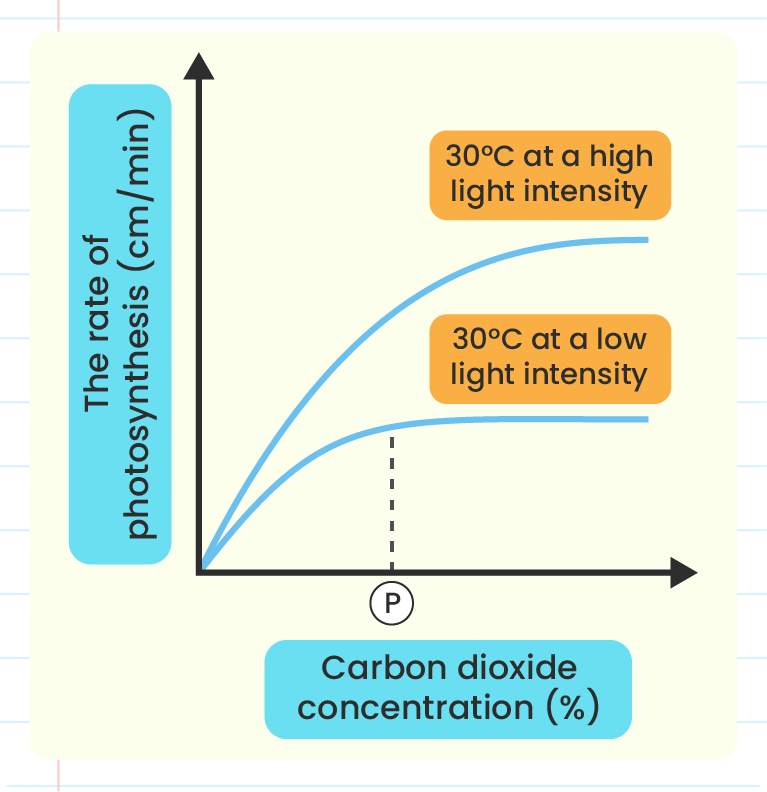
|
- Light is needed in the light-dependent reaction.
- If the concentration of carbon dioxide and temperature are constant, the rate of photosynthesis increases until it reaches its maximum point at noon.
- Graph I shows that the rate of photosynthesis increases with the increase of light intensity until it reaches a light saturation point at P.
- After point P, the increase in light intensity (from P to Q) is no longer increases the rate of photosynthesis because it is limited by other factors such as temperature and carbon dioxide concentration.
- Graph II shows when the concentration of carbon dioxide in the environment is increased to 0.13%, the rate of photosynthesis also increases.
- The graph below shows the relationship between the rate of photosynthesis and light intensity.
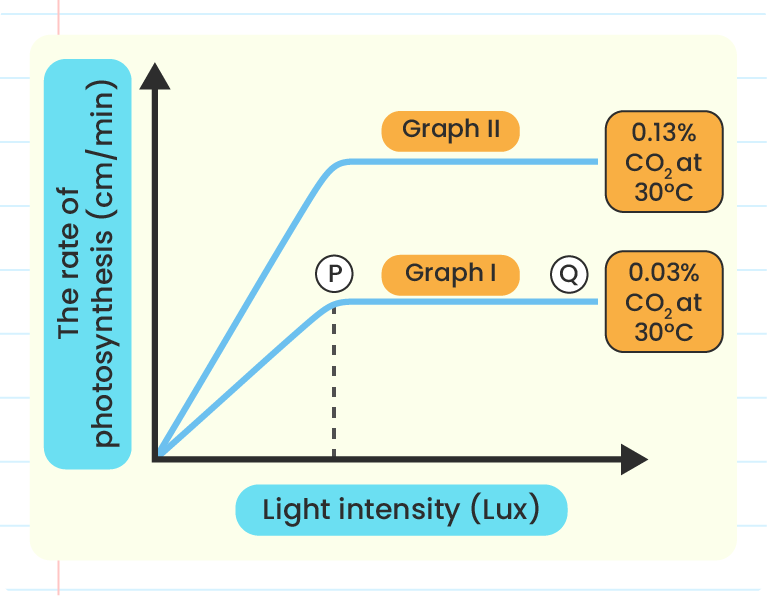
|
- The reactions in photosynthesis are catalysed by enzymes.
- Therefore, changes of surrounding temperature will affect enzyme activity and also the rate of photosynthesis.
- The optimum temperature is different for different plant species but in general, the optimum temperature is between 25°C to 30°C.
- A very high temperature denatures the enzymes and the process of photosynthesis is stopped.
- The graph below shows the relationship between the rate of photosynthesis and temperature.
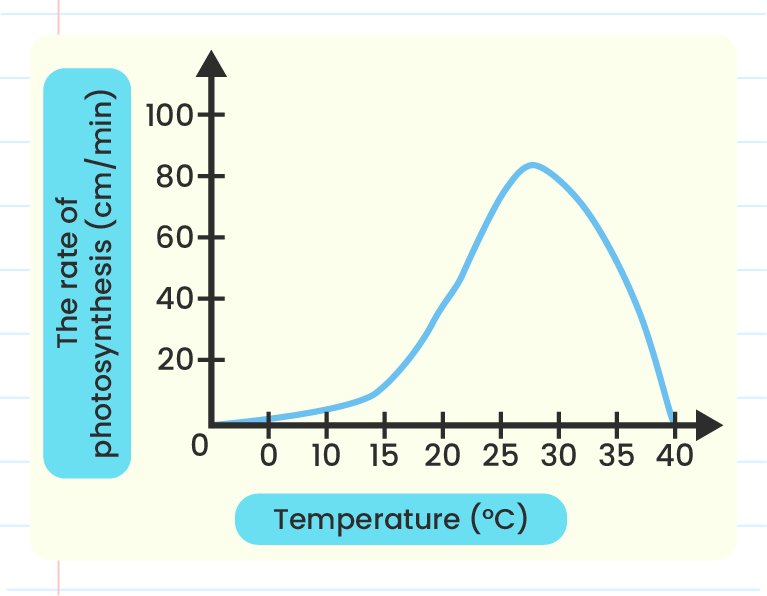
|
|
| |
| The Effect of Different Light Intensities and Light Colours on the Rate of Photosynthesis |
- The rate of photosynthesis in plants is different throughout the day.
- Other than the light intensity factor, the rate of photosynthesis is also affected by the colour of light.
- Light spectrum consists of seven colours in a certain sequence (violet, indigo, blue, green, yellow, orange and red).
- Each colour has a different wavelength.
- The rate of photosynthesis is the highest in red and blue light.
- All of the red light is absorbed by chlorophyll.
- The blue light is absorbed by carotenoid pigments before being transferred to the chlorophyll.
- These two lights have enough amount of energy to excite electrons in the light-dependent reaction.
|
|
| |